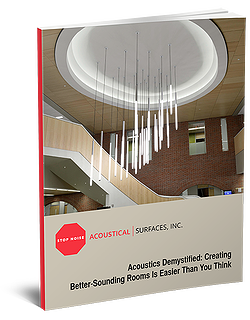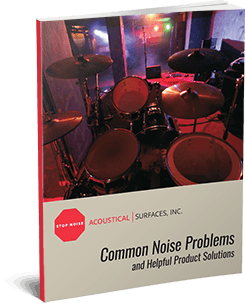How to Soundproof a Classroom 101
A classroom is an important space: it is where students will establish friendships, where they will learn things that shape their way of thinking, and where they spend much of their time each day. The quality of the classroom environment is instrumental to the focus and success of each student.
Unfortunately, due to the nature of many classroom activities, the room can get very noisy and distracting. Especially during games, free time, or instrument practice, the noise will reverberate throughout the room, creating poor room acoustics. Any bleed through the floor, ceiling, and walls could cause a disturbance to the surrounding rooms. Why should and how can we mitigate this?
The professionals at Acoustical Surfaces specialize in solving these types of problems. With a huge variety of sound solutions that can be custom-outfitted for your classroom space, we can help keep your noisy classrooms crisp and quiet.
Why Invest in Acoustic Solutions for Your Classrooms?
When it comes to soundproofing a classroom, it’s essential to consider the effects of classroom noise on adults and students. Even if we think the ambient sound in a room isn’t terribly disruptive, that may not be the case for those trying to teach and learn. Additionally, children are more susceptible to the adverse effects associated with excessive noise.
Background noise cancellation can help teachers hold students’ attention and protect their health. Something barely audible to adults can raise blood pressure in kids, impair their ability to concentrate, or even hinder their ability to learn speech and language.
Prolonged exposure to excess noise has been known to increase stress levels and anxiety in both children and adults, which snowballs into all kinds of problems with performance. On the other hand, keeping a more serene classroom can contribute to a general sense of calm. It’s a perfect environment for learning and productivity. So, how do we get there?
How to Improve Classroom Acoustics
Before diving into the different types of acoustic treatments for classrooms, we must first address the two main sources of sound: Those generated within the classroom and those generated outside the classroom. The difference between the two demonstrates the basic difference between soundproofing rooms and acoustically treating them.
Noises from inside the classroom
The noises we associate with a buzzing classroom usually originate inside the room. Students chatting, digging textbooks out of their backpacks, and sliding seats and desks around while they fidget in their seats. All the sounds of life happening.
These kinds of noises cannot be kept out of the room since they originate inside. The way to deal with this type of noise is through acoustical treatments that absorb and scatter sound waves. These acoustical treatments address the issues of reverberation and echo and are key to keeping background noise in check.
Noises From Outside the Classroom
The other type of noise we deal with in classrooms originates from outside. These sounds may come from a nearby highway, gymnasium, or even the cafeteria. They can be particularly loud and may be impossible for the teacher to control, meaning they are a continuous disruption to the learning process.
Our immediate reaction to this type of noise is usually to shut the windows or doors. It’s a natural instinct, but most aging schools’ windows and doors aren’t built to keep sound out effectively. Our classroom acoustics standards should be higher than that.
When you want to do something serious about keeping outside sounds where they belong, you’ll need to incorporate soundproofing materials. These materials add mass and density to walls, windows, and doors. They can also create an air gap between layers, adding to their soundproofing capabilities. This is your solution if you’ve got too much sound creeping in from outside.
How to Soundproof A Classroom: Acoustic Solutions that Work
If you aren’t familiar with modern acoustical treatments, you may be picturing foam egg cartons glued to the drywall. It’s not a very functional or attractive solution to classroom noise in school settings. Teachers like to plaster their walls with student artwork, motivational posters, and M.C. Escher drawings, so bland, bumpy foam rectangles don’t really fit the bill.
The reality is that today’s acoustical treatments are as practical and functional in the classroom setting as they are in controlling excess sound waves in the space. Here are a few of our favorite hand-picked options for reducing noise in the classroom:
Classroom Acoustic Panels: Echo Eliminator
Classrooms are ripe for reverberation. They are filled with hard, smooth surfaces, and they’re also filled with kids. That means the room is never silent. Some kid is always clicking a pen, smacking their gum, or scribbling out doodles. You may also have a noisy HVAC system contributing to unwanted noise in the background (learn how to quiet a noisy air conditioner). All these sounds combine to create ambient noise that interferes with the teacher’s voice and can negatively impact childrens’ performance in school.
Adding soft, porous surfaces is the best way to keep reverberation at bay. By absorbing some of the sound waves, we reduce the amount of ambient sound floating around the room. This means the teacher’s voice faces less competition, and the students are able to hear them more clearly. It can also positively impact retention rates when test time comes.
Manufactured from recycled cotton, which is the most affordable sound absorption material on the market, Echo Eliminator panels are a space-efficient way to battle reverberating echo in your classroom. These ceiling and wall covering sound panels are customizable in size to the exact dimensions of your room, blend in nicely with existing room aesthetics, and are Class A fire rated and 100% recyclable.
Modern classroom acoustic panels still add those soft, porous surfaces where you need them, but they also look great, no matter what look you’re going for. You can choose from dozens of beautiful colors or print custom artwork on them, meaning your decor pulls double duty. Many are tackable and resist mold and mildew, making them the perfect surface for classroom walls.
Acoustical Window Inserts
Sometimes, keeping outside noise from coming in is the best way to improve the sound in a classroom. If your class is regularly disturbed by noise from the outside, such as traffic or construction, consider a window treatment solution such as Climate Seal acoustical window inserts.
Much cheaper than replacement windows, these easy-install inserts fit over or inside the frames of your existing windows and can dramatically change the interior soundscape by limiting outside noise. In emergency situations, these inserts can be easily removed.
Window inserts lower stress and distraction levels by reducing the volume of unwanted noise in the room, making the room more energy efficient. The increased thermal efficiency of window inserts makes it easier to keep the room from getting too hot or cold. Keeping students comfortable is an essential part of creating an effective learning atmosphere.
Fabrisorb Decorative Panels
For a hearty sound-absorbing option with a dose of customized decorative charm, consider Fabrisorb panels for your ceiling and walls. Used by many professionals for sound-sensitive environments such as production studios, Fabrisorb panels are perfect for noisy classrooms with an emphasis on silence, or in music classes. These panels are custom-engineered and rated highly in sound performance and reverberation reduction.
Door Seal Kits
If you deal with a lot of sounds that originate from outside the room but inside the building, your door may not be doing you any favors. Classrooms generally have pretty thick doors, but the space around them allows for ample sound transmission. Often, sounds from down the hall to come creeping into the classroom
Luckily, if you are wondering how to soundproof a door, door seal kits do just that. Door seal kits are great acoustic solutions if you need a soundproof door. They sealup the space around your doors, helping the overall noise reduction process. They include everything you need to seal the sides and top of the door, and those with automatic door bottoms allow the door to swing freely over the floor but seal when the door is closed. It’s a small project with a big performance.
Flooring Underlays
If you are in the process of building or have the capacity for a remodel, then a more involved solution for your noisy classroom might be applicable. In this case, a commonly recommended solution for mitigating sound dispersion throughout your school building is a flooring underlay such as Akoustik™ Underlay. This simple solution involves the placement of a thin layer of synthetic fiber between the wood or tile floor and the wood or concrete subfloor.
Along with significantly reducing the impact of noise passed to the level below, Akoustik has a host of additional benefits. The thin layer will help smooth out minor imperfections in the flooring while remaining a lightweight product. It is also a recycled “green” absorption product that won’t break your budget.
In addition to these creative solutions, Acoustical Surfaces offers dozens more options to help create the ideal sound environment you need for your students. You can also consult our free resources to learn more about sound dispersion and absorption techniques that our professionals use on a daily to help solve real-world problems for our clients.
Acoustical Surfaces: Your Interior Sound Solution
Every classroom has a unique set of specifications and purposes – from small practice rooms to standard 30-student rooms, or orchestra halls. Each one requires a particular and custom-designed sound solution to create the best possible results for each student in the class…as well as for each student down the hall or up the stairs who could be disrupted by the noise the class creates. That’s why the professionals at Acoustical Surfaces will work with you each step of the way, providing everything your project will need: from consultation to final installation.
We leverage our experience in the industry as well as our deep catalogue of products to provide designers, architects, and builders with the solutions they need to build the highest quality rooms and environments. Trust Acoustical Surfaces to provide the materials and products for your next project. Get in touch with our technicians or browse our product offering by exploring our website today.





8 Comments
Lori Dawson
I’m trying to sound proof the door between my art room and the music room adjoining us. The sound of recorders is intolerable. How can I cut down the volume of noise? The walls are cinderblocks. Doors are wood. Music room has high ceiling and tile floor. Help!
Ted W
Lori,
Thanks for the comment!
Blocking sound from a door is generally fairly simple and straight forward. I always suggest starting with the door, re-assessing the situation, and then adding more if needed.
The addition of a Heavy Duty Door Seal Kit should greatly reduce the amount of noise that is making its way into your classroom. Sound acts like water and wants to travel via the path of least resistance first. If the music room were filled from floor to ceiling with water – how is that water going to get into your classroom? Yep, the gaps and cracks in the door. You know more about sound than you probably think you do. 🙂
Let me know if you have any more questions!
Thanks,
Ted
Tina Bohrer
I have two windows in my kindergarten classroom that connect to the pe room. They are about 2ft wide and 5 ft long. The school won’t help so anything I do will have to be done out of my pocket. Can u suggest a quick fix?
Ted W
Hi Tina,
Thanks for the question. I would suggest using some thick, heavy plywood or sheetrock and some standard sticky-back weather stripping so that the new barrier-product is as airtight as you can get it.
Imagine that you were trying to block water from coming into your room. The barrier first needs to be airtight as well as dense and heavy as possible. I would probably throw some kind of nylon strap or something over the barrier to make sure it doesn’t fall out. You could even get a nice curtain to cover it up, since you won’t be able to see through the window anyway.
Good luck!
Ted
Jose Salinas
I am an elementary music instructor. I am trying to stop any sounds from my room to the other classrooms. What is the best way to go about this? The only thing that is separating my room from the other rooms is regular drywall. The wall is about 25 ft. across. A little more than half of it has some wooden shelves and cabinets. There is about 2 feet of open space over the wooden cabinets.
Ted W
Whenever people make statements like wanting to “stop all sounds from my room to the other classrooms”, I get very nervous — especially when we’re dealing with kids and/or music of any kind. Realistically stopping all sound is going to take a significant amount of work and require major modifications to the wall. Starting to reduce the sound a little bit is usually a lot more attainable and realistic, but it also requires construction and modifications to the wall.
I do have a few questions about the wall or walls in question as it’s not quite clear in your comment. Does the sheetrock go from the floor to the ceiling, or do the walls stop a few feet from the floor? Or, was the mention about the cabinets just noting that they cover the sheetrock and stop a few feet from the ceiling?
The reason why I ask is that blocking sound needs to be done quite specifically to be done successfully. Sound is a lot like water in the fact that it uses the path of least resistance to get from point A to point B, so sound can be carried very easily through ducts, gaps and cracks in walls, doors, and windows, etc. Also, if the ceiling is simply T-bar grid and standard ceiling tiles and the wall doesn’t go all the way to the roof deck, much of the sound can actually go up and over the wall but sound like it’s coming through the wall.
If it is the wall in question, I would suggest exploring these products:
Green Glue Dampening Compound
RSIC-1 Clips
SoundBreak XP Enhanced Drywall
Please let me know if you have any questions or if you would like to discuss this further.
Thanks,
Ted
Batoul Raad
I am Batoul Raad from Lebanon, i am asked by the school to get a report about “how to reduce an echo in a classroom”. The thing is our school is ready to pay the expenses of this project, so we can apply it in every classroom in our school because it is a really big problem for us. i read several articles, but i am not sure yet. If you can help me that would be great.
Thank you
Ted W
Classroom acoustics are important indeed. I have a very simple equation that I would be happy to share with you.
18 × 20 × 10 = 3,600
3,600 × 0.03 = 108
I would choose something that is light, soft, and fluffy (and fibrous) and install that on the walls or ceiling of the space. This will make a noticeable difference in the echo/reverberation of the room.
Thanks,
Ted